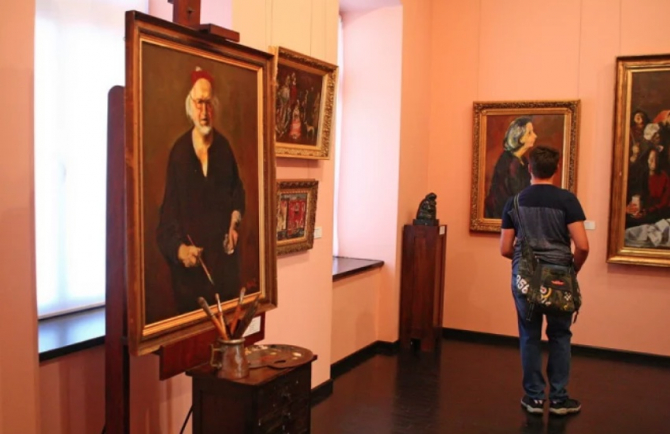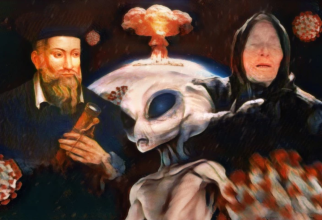From the Old City Center to 111 Calea Victoriei, you usually don’t spend more than seven minutes on two wheels and maybe double the time if you decide to walk. Moreover, when choosing this itinerary, you have the chance to cross the most beautiful part of the former Mogosoaia Bridge, starting from the National Military Circle and continuing with Capşa Hotel. Then you discover the Odeon Theater, the Telephone Palace, the Royal Palace, the Central University Library Carol I, the Atheneum, the Novotel Hotel, Athenee Palace, Radisson Blu Hotel, the White Church and many other architectural atractions, one more beautiful and more mysterious than the other. Various combinations between the old and the modern, these are a backbone without which we could hardly imagine Bucharest.
On the left side, going toward Victoriei Square, we enter a gate to reach a green garden, in which the timid ripple of a fountain tickles the silence of the statues spread through the garden of the Romanit Palace. Its royal air makes our thought wonder through all kinds of times. How was it then? The grains of time seem to have stopped for a moment, and yet they still slip through your fingers. But then it is art again that offers refuge, in pictures, expressions and colors.
The mysteries of the Palace started revealing themselves as we began our discussion with the MAC (Museum of Art Collections) museographer. The phrase "museum of collections" intrigues you. This is not just a museum that brings together individual works of art. The collections, the ensembles of works of art are themselves being exhibited, as The National Museum of Art of Romania (NMAR) representative warmly confessed.
The Romanit Palace - symbol of an increasingly romantic Bucharest
The Romanit Palace is one of the buildings on the Mogoșoaiei Bridge built at the beginning of the 19th century. In the Romanian Pricipalities a lot of documentation from that period was not kept as the Romanian archives only started to take shape in the second half of that century. The time when the palace was built is not exactly known but it is believed to be for several years after 1812. It happened as part of the process of urban consolidation of Bucharest, which occurred after 1802, when the wooden buildings and the slums of the Bucharest of those times were put to ground by a fire.
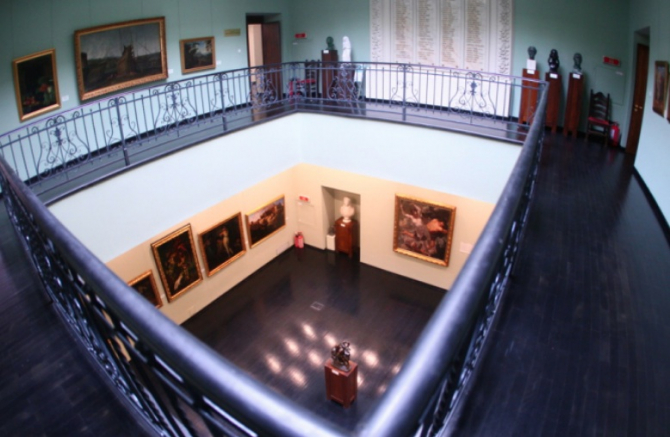
The overcrowding of the Romanian Palace was made towards the end of the 19th century, not in the first stage of building the DC News Archive.
It is interesting to see how this withdrawal from the road gives the place a feeling of enclave, of oasis. Tourists can come to the courtyard of the museum to read and to recollect themselves. The architecture is in neoclassical style, of European, Western inspiration. It was a very modern building at the time when it was built, with tendency towards the Western architecture, especially French – perhaps also influenced by contacts with the Russian cultural world -, with which the elites of that time were trying to assert themselves. Existing documents indicate that it was built by a certain Facca. Little is known about Facca, but it is thought that he was the father of Costache Facca (1801-1845), one of the founders of the Romanian dramaturgy. The descendats of Facca sold the building to its second owner, the treasurer Grigore Romanit or Romanet, with Phanariotic origins, and therefore the current name of the Palace. He had no descendants so the building was left to his sisters who at one point, in the 1830s, sold it to the state. Since then, until and during communism, it had various administrative functions until 1978 when the Museum of Collections was established and it was decided for this building to be allocated to it.
Additional floors were added to the Romanit Palace towards the end of the 19th century, but not in the first construction stage. It currently has three floors. The ground floor is reserved only for the Simu Collection, and walking across it you enter a new space which has the role of lapidary, located in the basement. In the 19th century, the interiors of the Romanit Palace looked radically different: wainscot, very elaborated stucco sculpture, Venetian crystal chandeliers and painted ceilings. So, the palace was built starting 1812, and it has been hosting the Museum of Art Collections since 1978.
The Museum of Art Collections - born after the 1977 earthquake
The museum was established after the earthquake of 1977. It seems that this sad event had pushed forward the decision to bring private collections, existing in Bucharest at that time, under the same umbrella. Also, it was done with the tought in mind for these to be protected and preserved in accordance with the norms of modern museology. Noteworthy is the fact that, unlike the case with most museums in the country and abroad, most of the patrimony held by the Museum of Art Collections can be seen because it is displayed.
Even before 1978 some of the collections were already owned by the state, but they were kept in various places, some even in the collectors' homes. Some collectors' houses, such as the one of Moise and Elisabeta Weinberg, had museum status themselves and could be visited on certain days of the week. The situation changed after 1978 when they were brought to the Museum of Art Collections.
In terms of its specificity, the museum is unique in the world. The Museum of Art Collections differs from an ordinary museum precisely though the fact that it gathers collections, ensembles, together with their history. Most of these collections were formed in the second part of the nineteenth century and in the first half of the twentieth century, according to criteria related to the collector’s personal preferences or to the value criteria of the respective era.
It all started from 13 collections in 1978 and today there are 51 collectors’ selections. All modern Romanian art from the 19th century and the first half of the 20th century is represented because the collectors were contemporaries with the artists whom today we consider canonical. Here are some examples: Aman, Grigorescu, Luchian, Iser, Petrașcu, and Tonița. By comparison, Western art was less present in the Romanian collections, though an eloquent selection in this regard is the collection of spouses Elena and Anastasie Simu, whose heritage is currently preserved both at the Museum of Art Collections and at the headquarters of the National Museum of Art. Collections can be very small, from 1, 2 works, to very large, of over 1000 works. It is interesting that many doctors are among the collectors. Probably due to the fact that the artists were among their patients.
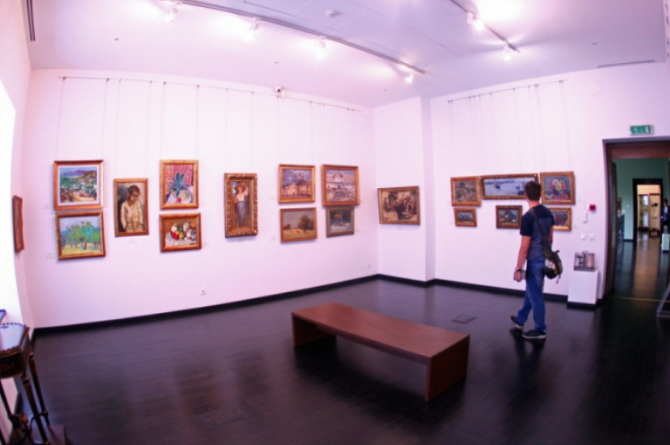
The museum was closed between 2003 - 2013 due to extensive renovation works DC News Archive
Types of collections - monographic and heterogeneous
A monographic collection consists exclusively of the works of a certain artist, found in his or his family’s possession at his death and subsequently donated to the state by his successors. Examples: Iser, Baba, Alexandru Phoebus, Idel Ianchelevici or Simion Iuca, the latter being recently donated. A heterogeneous collection, on the other hand, is put together by an art lover, and it contains a various number of artists.
The "Elena and Anastasie Simu" Collection - The Museum in the Heart of MAC
On the ground floor, entering through the Central Body, we find Anastasie Simu's art collection, with a distinct feature in the Museum of Art Collections. While most of the Romanian collectors were passionate about Romanian art, Anastasie Simu, their contemporary, insisted on having Western art works in his collection. In the Simu Museum, the first museum in Bucharest, the works were exhibited based on the art schools they were coming from. There are a lot of names of Western artists, important names from the period between the 19th and the 20th century, which may not say much to us today but if we were to look at the newspapers from the first three decades of the past century, we could see that those artists were then popular. We see how unwritten functioning laws of art history change hierarchies. Over 600 works of the former Simu Museum are now in the Romanit Palace, belonging to NMAR, through the Museum of Art Collections.
It was French art, German and Austrian art and more, because Simu's approach was also educational, pedagogical. At that time, the field of art history was still in incipient phase in Romania. There was no information, access to images, reproductions, not everyone could travel. Therefore, he tried through his collection to create a panoramic view of the European art history, to synthesize it and bring it to Bucharest.
The Story of the Simu Spouses Busts
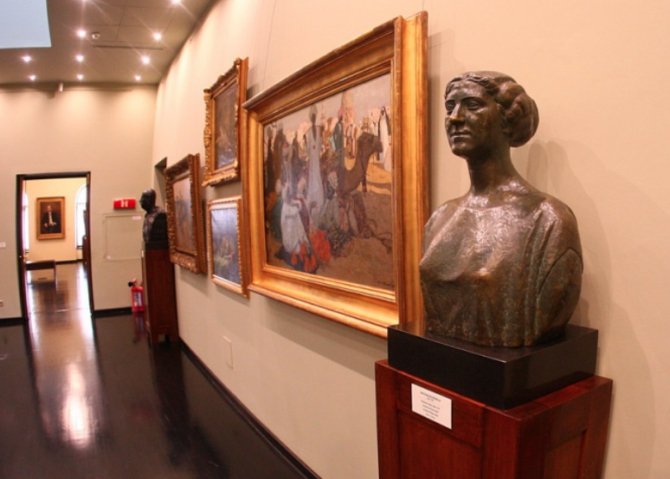
The order took a very long time since the First World War began DC News Archive

We find here the busts of the two Simu spouses. In 1913, Anastasie Simu wanted to get in touch with the French artist Antoine Bourdelle, a disciple of the famous Auguste Rodin, and who was highly appreciated at the time, to launch an order for his bust. Initially for his wife's portrait (1913), and later for his portrait. A marble version of these two portraits is found at the Royal Palace, where the NMAR headquarters are also located. It was an order with adventures, and the correspondence between Anastasie Simu and Antoine Bourdelle is still kept. Simu visited him at his workshop in France. The order took a very long time to complete since World War I began after the order had been launched. Thus, due to the more turbulent period, Bourdelle was late with the delivery of the order. The bust of Elena Simu arrived in Bucharest only in 1920.
Simu's portrait, Adler's masterpiece
We also discover Jules Adler (1865-1952), an unknown name today but who was then considered important enough to represent France at the Venice Biennale, with his work Night Watch (1906). Pierre Gourdault (1880-1915) was another artist considered important during those times, and who painted Simu’s portrait.
The painter died prematurely at the age of 35, during the First World War, and his fame increased posthumously. In the museum's warehouse there is also a very large work by Gourdault, his only work with a historical subject, entitled Year One Thousand. This was exhibited in 1907 at the Salon in Paris and Anastasie Simu wanted to buy because it was very well reviewed. The entire history of the acquisition of that work is revealed to us in the memories of another Romanian collector, Zambaccian. Retrospective exhibitions were dedicated to Gourdault, and he was posthumously decorated. Though, Simu's works date from the early period of his career.
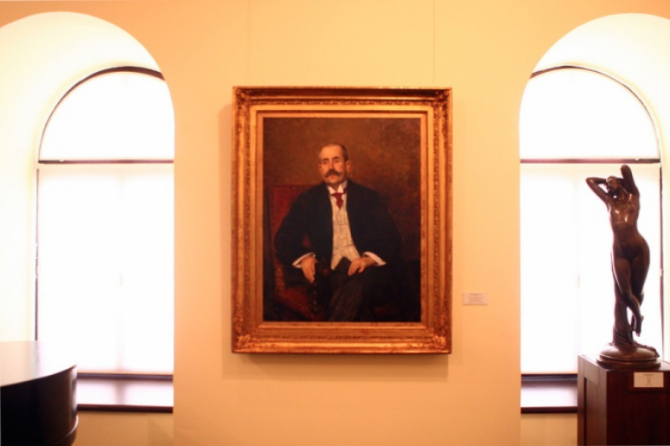
Pierre Gourdault (1880-1915) the one who painted the portrait of Simu Archive DC News
At the ground floor room, among the works that belonged to the Simu spouses, concerts take place occasionally. Several editions of the event FANtastic Opera organized by Luminița Arvunescu were held in here.
Summarizing the story of the Simu museum, we notice that for 17 years it remained in its founder’s property, then for the following 8 years, when Anastasie Simu was still alive, it belonged to the Romanian state, and after that it survived for 25 more years before being demolished in 1960. Interestingly, besides donating the museum to the state in 1927, he also left the state a sum of money for new acquisitions to be made after his death.The museum was built between 1907 and 1910.
Apollo and Daphne
Simu collected Renaissance and Baroque art, as well. One of the oldest works in his possession was Saint Catherine of the Wheel, her instrument of torture. This was a replica from the end of the sixteenth century, after an original by Petrino Giannino, called Giampietrino, a disciple of Leonardo da Vinci. The work was purchased from Milan, where the painter worked, same as Da Vinci.
Another interesting work is Apollo and Daphne (1640-1687) by Pietro Liberi (1605-1697), a very important Venetian artist of the seventeenth century.
Art historian Cosmin Ungureanu, curator within the European Art section of NMAR, has managed to identify the author, and the work has been recently restored. Daphne's posture gives the impression she is about to come out of the painting itself, as if she were flying in the viewer's space, and this increases the impact of the work.
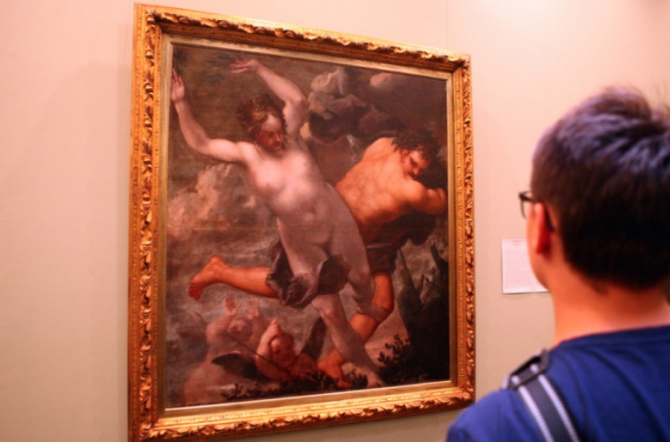
Apollo and Daphne (1640-1687) by Pietro Liberi (1605-1697) DC News Archive
The "Corneliu Baba" Collection - the Colours Left on the Palette
In the section reserved for the Corneliu Baba Collection (1906 - 1997) we find works belonging to the artist alongside with his personal objects. Some objects from the workshop, even the brushes with which he painted, a sketchbook, the palette, a desk, a work table, objects that were part of the ambience of his daily life. Seeing the coulours on the palette makes it all quite exciting.
I found out that visitors were interested in such objects, because of this myth which exists in modern times: the myth of the artist and practically of everything he touched. And this is of a certain importance for the art lovers. Furthermore, these elements help the specialists decipher aspects of the creation process. For example, in the collection of Iosif Iser, there are objects that were in his house, objects for everyday use such as tableware, which he also represented in his paintings. Thus, at the Museum of Art Collections the objects can be seen alongside the works in which they were represented.
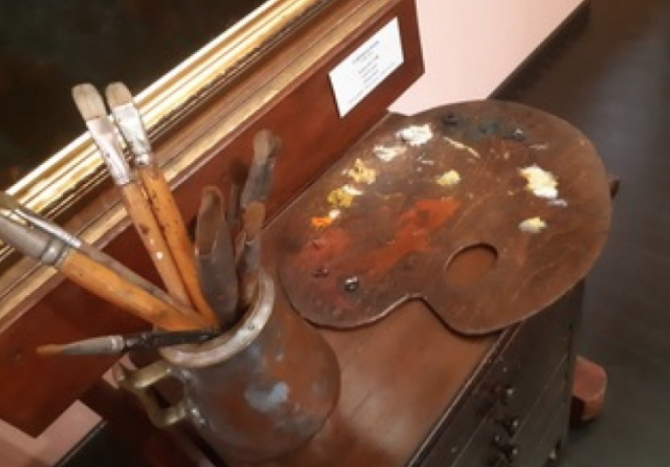
Corneliu Baba's painting tools Archive DC News
Baba lived his youth during the interbelic period. A special portrait that he painted is the one of George Enescu. The painter was passionate about music. The violin that belonged to the artist is among the objects which are exhibited in this collection, and it can be seen during the month of September 2019.
This is how I found out that those who come to the Enescu Festival can also see who painted Enescu. The Education and Communication section of the NMAR (National Museum of Art of Romania) has thought of a route that crosses the Museum in search of works of art with musical subjects.
On the left side we find works from the famous series of paintings The Mad King. Some art critics have given these works an interpretation in the political context from the end of the communist regime: the dark palette, this type of "expressionism", the despair that could be read on the faces of the characters has been interpreted (sort of) as a form of resistance through art. Baba was considered a pennant artist even before 1989. It is possible that in the 80’s he experienced certain anxieties. He was a professor at the Nicolae Grigorescu Institute, today’s UNARTE, in the vicinity of the MAC. He was one of the most appreciated and famous teachers, at the Painting department, together with Ciucurencu, and many contemporary artists identify themselves with one or the other. Therefore, the Romanian painters are sometimes divided into "babiști" and “ciucurentiști ".
The "Elena and Dr. Iosif Dona" Collection
This is one of the most important and the oldest Romanian collections. The phenomenon of Romanian “collectionism” began sometime in the second half of the 19th century. Basically, there were no rules for collecting. Each person proceeded as he or she considered, and the personal taste was a very important factor. The "Dona" collection is important because all the stages of modern Romanian art are found here, starting with Aman, Tattarescu and continuing with Grigorescu, Luchian, Iser, Petrașcu, and Tonița. All the prominent names of Romanian art are represented here. It is a heterogeneous collection. Doctor Dona’s passion for collecting was passed down from his family.
The Dona family got to be related at some point to painter Nicolae Grigorescu. One of Iosif Dona’s nieces(?) was married to Nicolae Grigorescu's son, Gheorghe. Iosif's Dona collector activity started early, influenced by his father, General Nicolae Dona. His collection started with a work by Grigorescu. Here we have painting entitled "Apple flowers" which was bought by I. Dona at the age of 27.
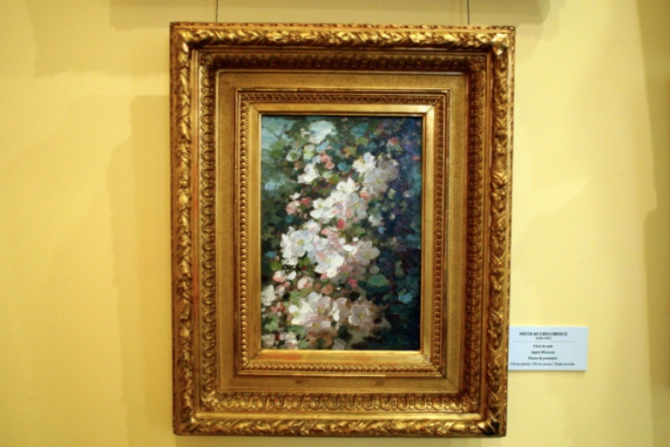
The "Dona" collection is also important because all the stages of modern Romanian art can be found here Archive DC News
A small but significant work from the same collection illustrates Nicolae Grigorescu’s first workshop in Paris. That was an important period in Grigorescu's formation. The painting shows us the environment in which the artist worked in Paris, and since there are not many documents regarding Grigorescu’s stay in Paris, it all becomes more important. He was one of the painters working at the Barbizon. Grigorescu was one of the first Romanian artists who had Western formation experience. Most Romanian painters had Parisian experience at the beginning of the 20th century but in the mid-19th century it was not so common. Grigorescu initiated the procedures and eventually obtained a scholarship to study in Paris, and then to extend his stay. He came in contact with the painters from the Barbizon who were painting in open air, and this is the time when Grigorescu fell in love with the natura frustra.
The "Hurmuz Aznavorian" Collection - the Politician Who Died at the Canal
I have now entered a small room where the Hurmuz Aznavorian collection is displayed. It comes with a story, though. Aznavorian's family suffered greatly once the communist regime was established. Hurmuz was a lawyer and a politically involved figure, member of the Liberal Party. With the Communists coming to power, he had to go through heavy years of imprisonment, and died in the forced labour camp at the Canal (while building the Danube-Black Sea Canal). In the new situation the family survived due to the collection which they had to sell in order to survive in those persecution years, the 1950s. These 36 works remained, out of almost 400 which made up the collection initially.
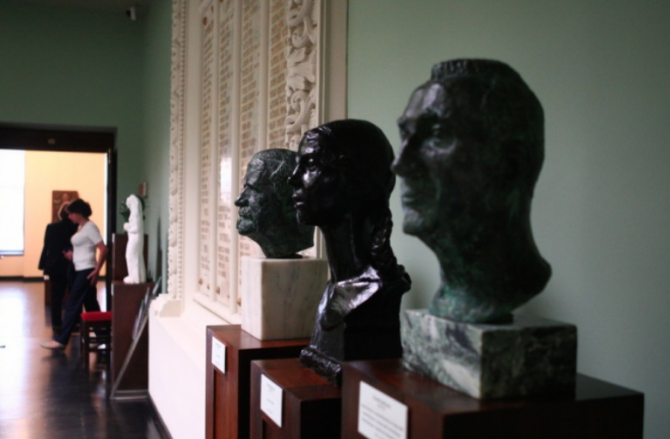
There were 36 works out of almost 400, as the collection originated from the DC News Archive
On the hallway from the transparent wall we find the works of Céline Emilian (1898-1893) born in Paris, to a Romanian family. She was active in Romania during the interbelic period. She constantly exhibited at all important exhibitions, she was very well reviewed, and enthusiastically received by critics, even though today her name seems to be forgotten.
The "Marcu Beza - Hortensia and Vasile G. Beza" collection
I reached the second floor and entered a spectacular place, practically another universe. Here was the collection of Marcu Beza, writer, historian of literature and Romanian diplomat, member of the Romanian National Committee, an exile organization formed in 1940 in London. He was passionate about oriental art, and the works he brought from his travels to Asia, Europe and Africa give his collection a hybrid character. It is also an art collection, but also an ethnographic one. We are in the Oriental Chamber, the so-called "the Arab Room", which existed in the collector's residence and was then reconstituted in the museum.
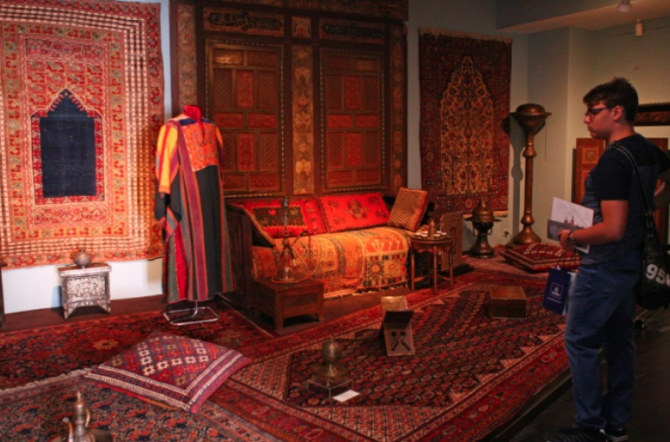
The "Marcu Beza - Hortensia and Vasile G. Beza" Collection "DC News Archive
Beza studied in London, lectured at King's College, wrote books on the history of English literature, wrote about the English Romanticism, edited the first Romanian grammar translated into English, in London, and then an edition of Ion Creanga's works. He was an ambassador of Romanian culture and values. He was a diplomat in Jerusalem.
The Collection of Japanese Artist Shizuko Onda
She is a contemporary artist, born in 1936. After an exhibition held in the early 1990s in Bucharest she donated her works to the Museum of Art Collections.
MAC is a fascinating place, with very many stories. Not just 51, but many more. From the individual stories others are branching out. These are stories that encapsulate a part of Romania's history of the last two centuries. It is a pleasant space to be in, both outdoors and indoors, and is a unique museum formula.
An important thing to note is that the museum is open on Mondays and Tuesdays, when the other museums are usually closed, and it is closed on Thursdays and Fridays.
"Collectors actually donated to the people"
When I left I randomly asked a foreign visitor and a Romanian visitor at MAC about the impression they were left with, especially the atmosphere they found inside:
"I like the museum and I find it especially interesting because it is focused on Romanian artists, and we are not used to seeing them abroad. In France, Germany or the UK we find very few of their paintings and I think it is a good idea for Romania to promote and to take care of its own culture. I really like Ciucurencu. I found him coming here and that was my pleasure. If I were to choose between Ciucurencu and Baba, I prefer Ciucurencu, because Baba is interesting but very dark and Ciucurencu is more colorful and optimistic. I read about the concept of the museum, the fact that it is made up of collections and I find it interesting. ”- Louis, from Paris.
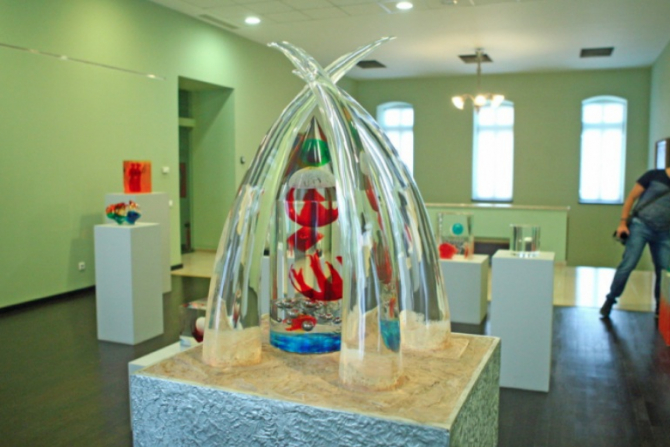
Collectors did not donate their collections to the state, but to people who can have unhindered access to the beauties they have gathered and cared for the DC News Archive
And Lucian, from Bucharest, said: “The Museum of Art Collections is an example of the patronage spirit of the class collectors. They understood that art was not meant to be kept in a safe box, hidden, but admired and that it must please the public's eyes. The collectors did not donate their collections to the state but to the people for these to have unrestricted access to the beauties they had gathered and cared for. Thus, the collections are alive and can inspire new collectors. "
There would be a lot more to say but I would like to end this writing by thanking the people who have these precious treasures in custody for their kindness. That's how I said goodbye to the mysteries of the Romanit Palace and I headed to Calea Victoriei in search of a new destination that would fill my soul with joy and color.
Fiți la curent cu ultimele noutăți. Urmăriți StiriDiaspora și pe Google News


